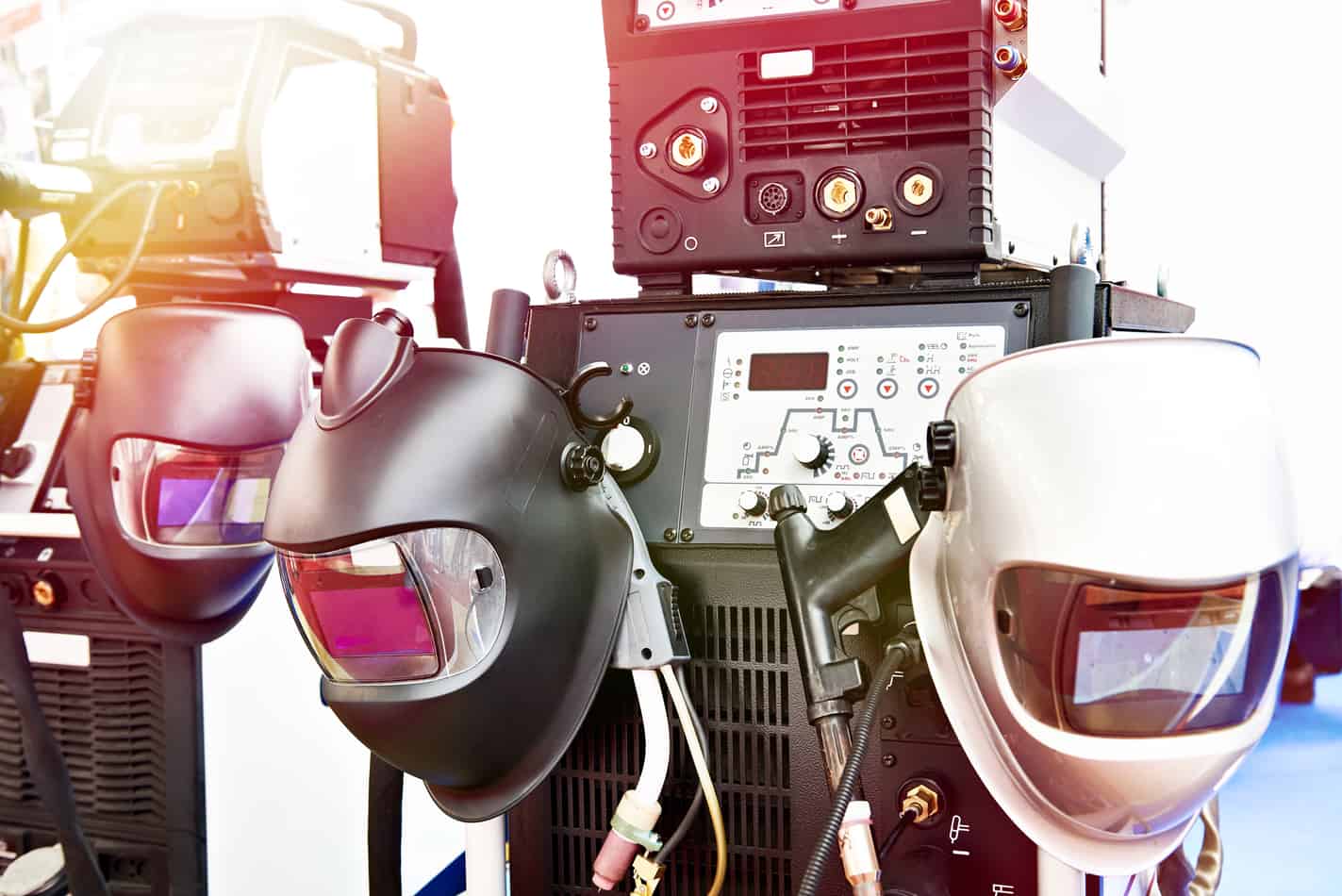“This post contains affiliate links, and I will be compensated if you make a purchase after clicking on my links.”
Welding can be a dangerous activity. Between the light of the arc, sparks, and spatter, it is especially hazardous for your eyes. You must wear eye protection when welding or the arc burns your eyes. The best eye protection for welders is a full-face helmet that not only limits light coming in but also protects your face from sparks and spatters.
When it comes to welding helmets, there are a lot of choices out there. Passive or active darkening, variable tint, power sources, lens sizes – it can be confusing to sort through all the different options. How do you know which TIG welding helmet is right for you? Read on to find out.
Note: everyone talks about welding “helmets,” but they aren’t head protectors like army helmets, hard hats, or football helmets. Welding helmets are shields that sit in front of your face. The only time they are above your head is when they are flipped up because you aren’t welding.
Safety Standards
The first thing to look for in a welding helmet is safety. The American National Standards Institute (ANSI) has published a standard set of tests for safety gear to pass. The standard for eye protection (including welding helmets) is ANSI Z87.1. This standard sets out regulations for how much infrared, visible, and ultraviolet light the helmet must block out. It also dictates impact resistance and other safety features.
Choose a helmet that is Z87.1 compliant to make sure you are getting real protection. Helmets that aren’t compliant either haven’t been tested or haven’t passed the test in some way. Your eyesight is not something to gamble with, so make sure to use a Z87.1 compliant helmet.
The federal Occupational Safety and Health Administration (OSHA) has adopted Z87.1 as the official rule for workplace safety as well. That means that, if you are buying a helmet for work, you don’t have a choice about Z87.1 compliance – it’s the law.
Passive Helmets
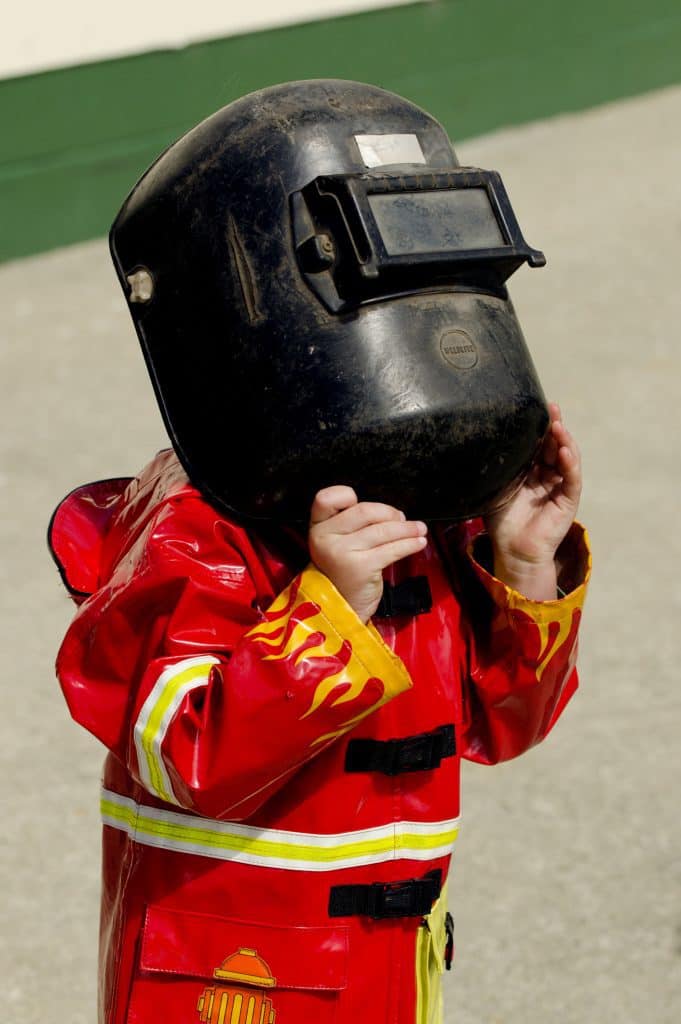
The first decision to make is whether you want a passive or auto-darkening helmet. Passive helmets are the least expensive models. These have an eye shield that is always dark. This is the traditional welding helmet. Flip it down, and you are safe. You are also almost blind until you crack an arc.
The darkness of the eye shields is rated from 9 to 14. (Numbers 1 to 8 aren’t dark enough for welding, so they are only used with safety glasses.) TIG welders usually use shades 9 to 13. Stick and MIG welders use shades 10 to 13, so go darker if you do other kinds of welding.
The least expensive welding helmets have a fixed eye shield. If you buy a number 9, that is what you are stuck with. Others have a replaceable eye shield so you can go lighter or darker if you prefer.
The darkness is the biggest drawback to passive helmets, especially for new welders. Once you flip the mask down, the eye shield is so dark you can’t see your electrode or torch. That can make it hard to scratch-start an arc. If your hands move when you flip the helmet down, you might start your weld bead in the wrong place. It can be hard to get good welds when you lose track of where your hands are.
The other problem with passive helmets is the constant up-and-down. Since you can’t see with it down, you have to keep flipping the helmet up to do other things. When it’s time to weld, you get your hands in position and snap your neck down to cover your face. When you’re done, flip it up to see how you did. When you are ready for the next weld, snap your neck to cover your eyes again.
If you weld all day every day, the repeated neck motion of flipping the helmet down can cause neck problems. It’s not a big deal for weekend warriors, but it can be for welding pros.
One solution to this problem is the flip-up eye shield. On these helmets, you can reach up and lift just the eye shield while leaving the mask in place. It lets you switch between welding and other work a little quicker with less neck motion. These screens still require a neck flip to close, but it’s smaller.
Auto-Darkening Helmets
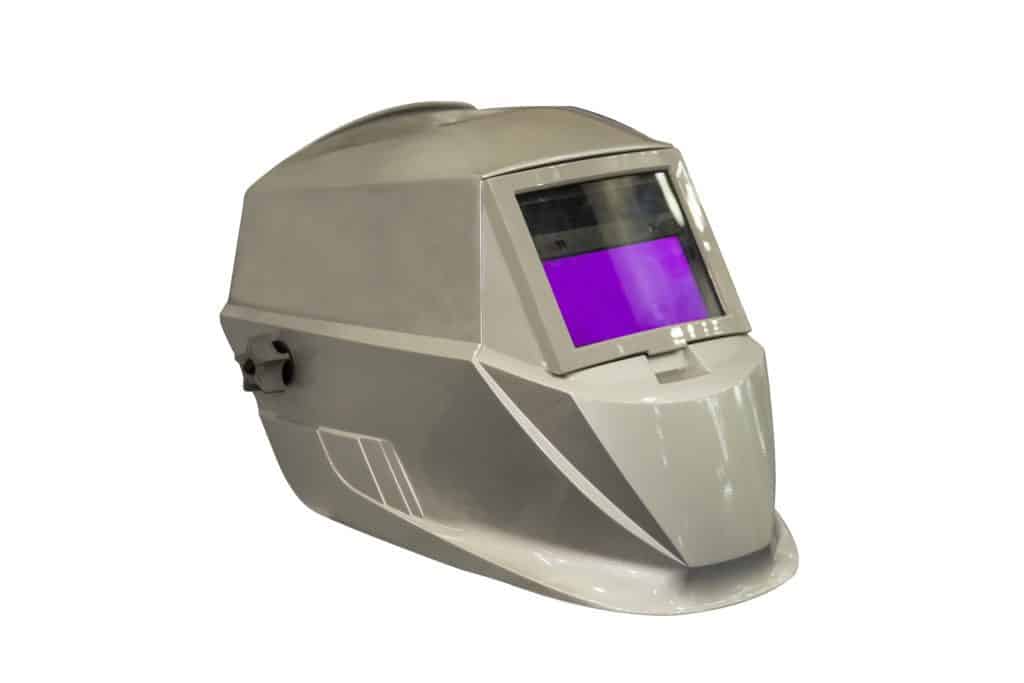
The high-tech solution to the drawbacks of the always dark passive helmet is the automatic darkening helmet. These helmets have an LED plate instead of the fixed-darkness eyeshade. When you aren’t welding, the plate is like looking through weak sunglasses. When you crack an arc, the eyeshade darkens instantly to protect your eyes.
Auto-darkening helmets eliminate the constant up-and-down and let you see what your hands are doing before you start a weld. These helmets are great for ergonomics, but they cost a lot more than a passive helmet. They also introduce a lot of new variables into the helmet equation.
Fixed or Variable Darkness
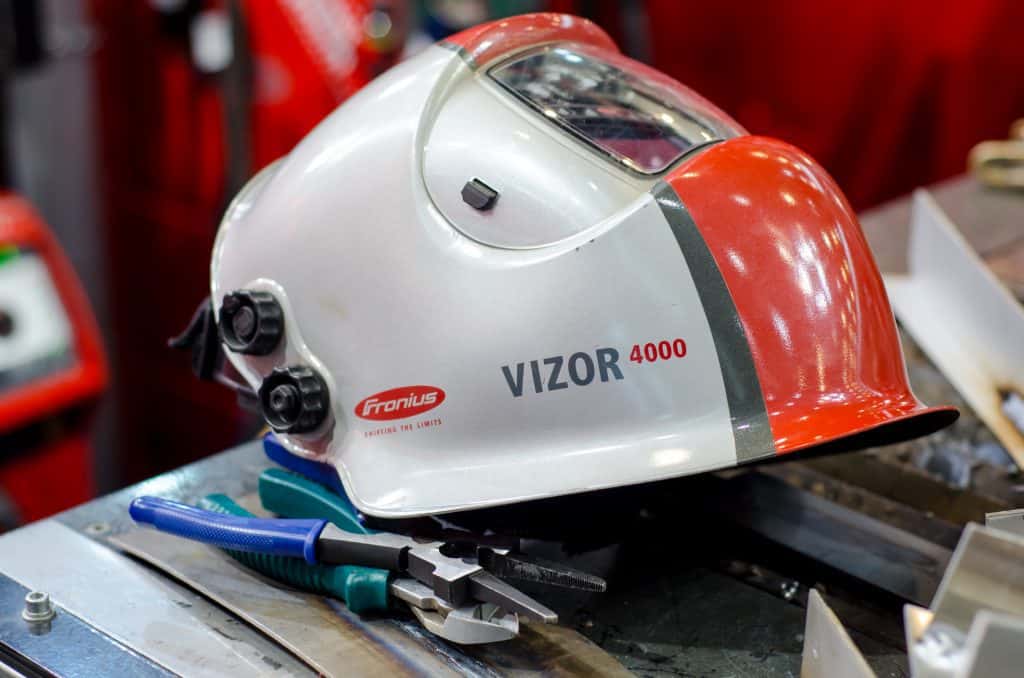
Some auto-darkening helmets can only flip between two levels of darkness. These are called fixed auto-darkening helmets. A fixed helmet will always flip from, say, three to ten when you crack an arc. No matter what amperage you use, no matter how bright the arc, it will always hit the same level of darkness. These helmets are good if you always weld the same thing in the same way.
Variable darkness helmets can be adjusted through a range of darkness. If you are doing low-amperage TIG welding, you might set the helmet to nine so that you can see what you are doing. On the other hand, if you crank the amps all the way up for stick welding, you can set the darkness to 13 to get the most protection. These helmets tend to be more expensive than fixed auto-darkening helmets.
Power Source
Since auto-darkening helmets use LED screens to protect your eyes, they require some kind of power source. There three options for power: AAA batteries, lithium batteries, and solar power. Each one has advantages and disadvantages.
AAA Batteries
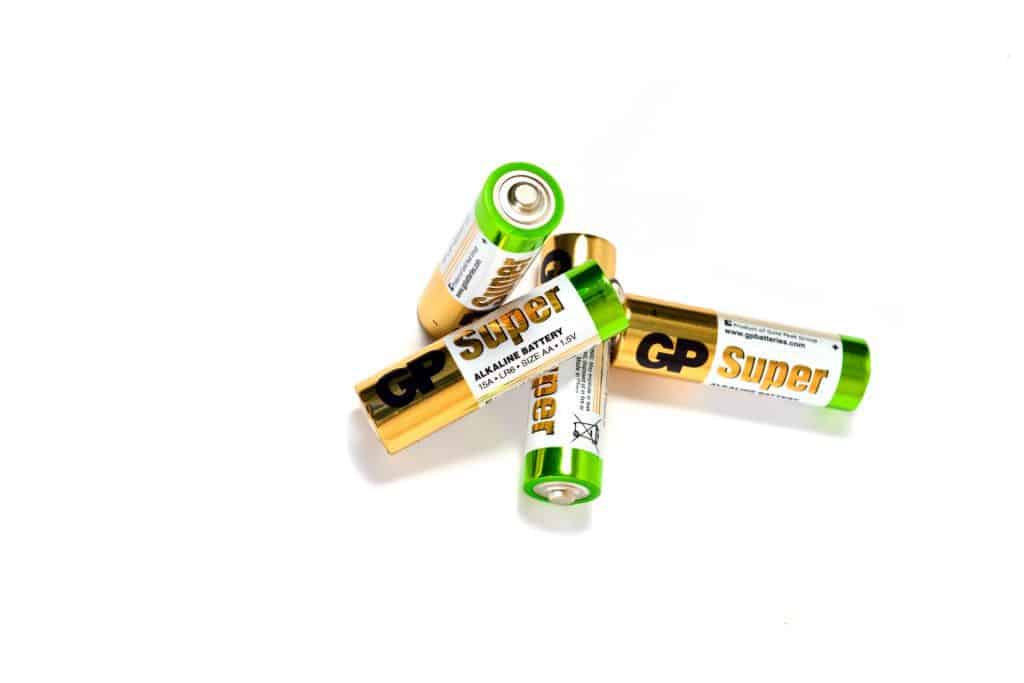
Triple-A batteries are common and cheap. They are the easiest power source to replace but have the shortest life. If you need to replace your helmet batteries, you can pick up AAA batteries anywhere – even the gas station on the way to work.
Helmets that use AAA batteries are the most likely to cause a “battery flash.” Battery flash occurs when you crack an arc with the helmet battery expired. Since the helmet doesn’t have power, it won’t darken, and your eyes will get flashed by the full force of the arc.
Lithium Batteries
Lithium batteries have a longer life than AAA batteries but are more expensive. Lithium batteries are also harder to find than AAA. If you need to replace them, you can’t just go out to pick them anywhere. Often, lithium batteries have to be ordered online. This means waiting at least a day after the battery dies before you can weld again.
Solar Helmets
Some helmets have a small solar panel that recharges the lithium battery. These helmets are the most expensive but also the most reliable. The helmet will recharge the battery while you work outside.
There are two times when solar helmets won’t work: right out of the box, and after a long time in storage. If the helmet has been kept in the dark for an extended period of time, it won’t have any charge. You can fix this by letting your helmet sit in the sun for a couple of hours.
Dark Time
Auto-darkening helmets have different lag times between detecting the arc and darkening. Lower priced helmets will get dark in 1/3600 of a second, while top-end helmets can go dark in as little as 1/25000 of a second. While these tiny fractions of a second seem too small to matter, they can make a difference if you weld all day.
For welding pros, the faster dark time makes a difference when they stop and start arcs all day. If you spend forty hours a week welding, the faster darkening time adds up. If you are just welding for a couple of hours on the weekend, it probably doesn’t matter as much.
If you weld in cold conditions, check the helmet’s minimum temperature rating. When the helmet is too cold, the reaction time required to darken the screen increases. Slow reaction times can lead to arc flash. Helmets are available that work in temperatures as low as 14°, but you need to check the specs for your helmet before you count on it.
Arc Sensors
Auto-darkening helmets usually have two sensors to detect the arc, but some have four. Helmets with more sensors cost more. The extra sensors are useful if you weld in odd positions, such as above your head or below ground level. They will pick up the arc no matter where it is. If you usually weld at a workbench at a comfortable height, the extra money for additional sensors is probably not necessary.
Sensitivity Control
Some higher-end helmets allow you to control the sensitivity of the mask. This lets you adjust how bright an arc will darken the lens. The ability to darken the lens with a smaller arc is useful when you are TIG welding at low amperages; it guarantees your eyes will be protected even if you have just a tiny arc. Of course, adjustable sensitivity adds cost. It’s worth it for low amperage TIG welders, but not for stick or MIG welders.
Delay Time
The delay keeps the lens dark for a brief time after the arc ends. Short delays are excellent for tack welding because you can see to reposition yourself sooner after finishing a weld. Short delays are also useful for working big jobs because you can see to line up your next weld faster.
Long delays are suitable for welding at high amperage, where the metal continues to glow for a time after the arc stops. The longer delay will keep your eyes safe while the weld bead cools.
Some helmets have adjustable delays. These helmets let you control the delay time based on the job at hand. This is a nice feature, but it also comes at a higher cost.
Other Factors to Consider
Whether you choose a passive or an auto-darkening helmet, there are some other factors to consider. These factors apply to both helmet styles equally.
Lens Size
Welding helmets are available with lenses that range from tiny viewports to huge, almost full-face windows. Bigger lenses let you see more of the work area while you weld. If you are working on a bench, a full view isn’t that important. You can just set up with a good view of your hands and go. On the other hand, if you are welding overhead or at other odd angles, a bigger view makes it easier to see your hands without straining your neck.
The best way to figure out the ideal lens size is to try on several different helmets. Put your body into a position like you are welding and check whether you can see your hands without putting yourself in an awkward position. This can be hard with a passive helmet – you won’t be able to see much of anything with a passive mask on, but you can get a good guess while wearing a helmet.
How Dark?
The ideal darkness you need is a function of the amperage and type of welding you are doing. Recommended shade for different processes are:
- Stick welding from 30-500 amps: darkness 9 to 13
- TIG 5-300 amps: darkness 9-13
- MIG 80-500 amps: darkness 10-13
- flux core 100-400 amps: darkness 10-13
- MIG aluminum 80-350 amps: darkness 10-12
Helmet Fit and Comfort
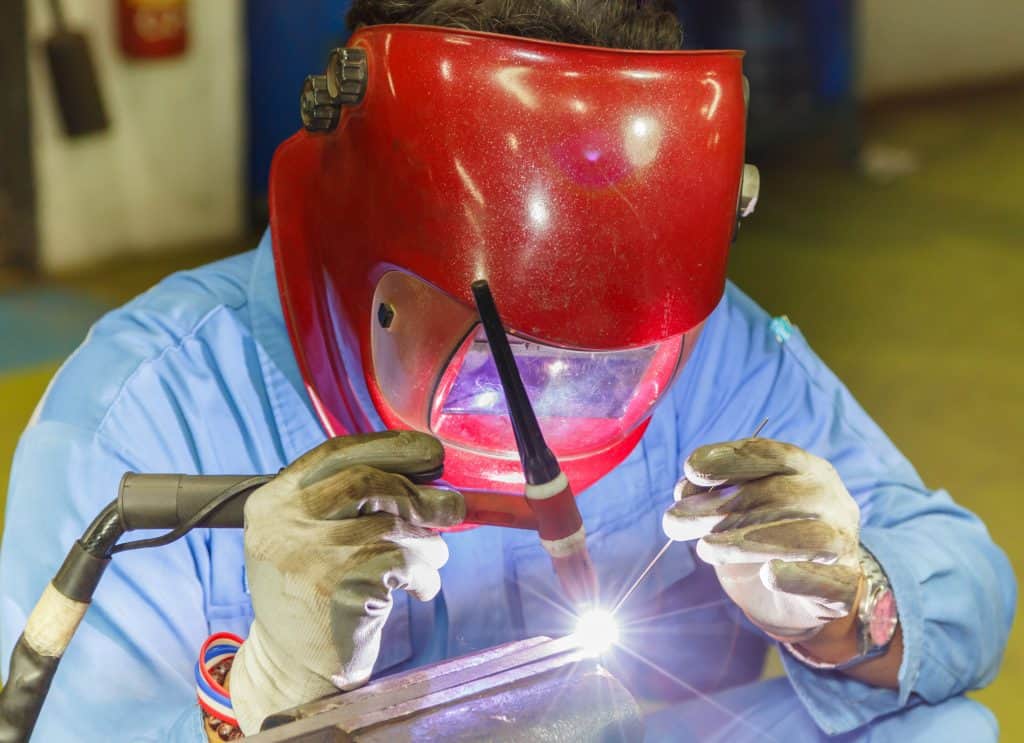
Achieving a good, comfortable fit is one of the most critical factors in choosing a welding helmet. The fanciest helmet in the world is no good if it makes your neck hurt. Lighter helmets are usually better because they are less fatiguing for your neck. If you can, go to a welding supply shop and try on several different helmets to see what feels best to you.
The helmet should fit snugly around your head without being tight. It shouldn’t wiggle when you move your head. You want the helmet to be stable and not slip around while you are working. Make sure there is enough clearance between your face and the mask; you won’t want to weld all day with your nose squished by the helmet.
Practice As You Play
When you try on helmets, make sure to wear the same equipment that you use to weld. At a minimum, try on helmets while wearing a welding cap or welding bandanna. Welding headgear is made with flame-retardant material. It will protect your ears and the top of your head from stray sparks and slag. It also makes you look like a real welder.
If you wear a respirator while welding, bring it along when you try on helmets, if you can’t wear the respirator under your helmet, the helmet is not a good choice for you. Get a helmet that fits you the way you weld.
Other Factors
If you are buying an expensive helmet, check out the manufacturer’s website for warranty information and parts availability. Welding can be hard on equipment. You don’t want to drop a lot of cash on a helmet that can’t be fixed or replaced when something goes wrong.
Graphics
It shouldn’t be the top factor in choosing a welding helmet, but graphics can be a good tiebreaker. You can’t show much personality with your face covered, but a sweet picture on the helmet can show a little about you. Feel free to get flames, a screaming eagle, or anything else that catches your fancy. Or don’t, if you want to come across as a no-nonsense kind of welder.
What About Goggles and Glasses?
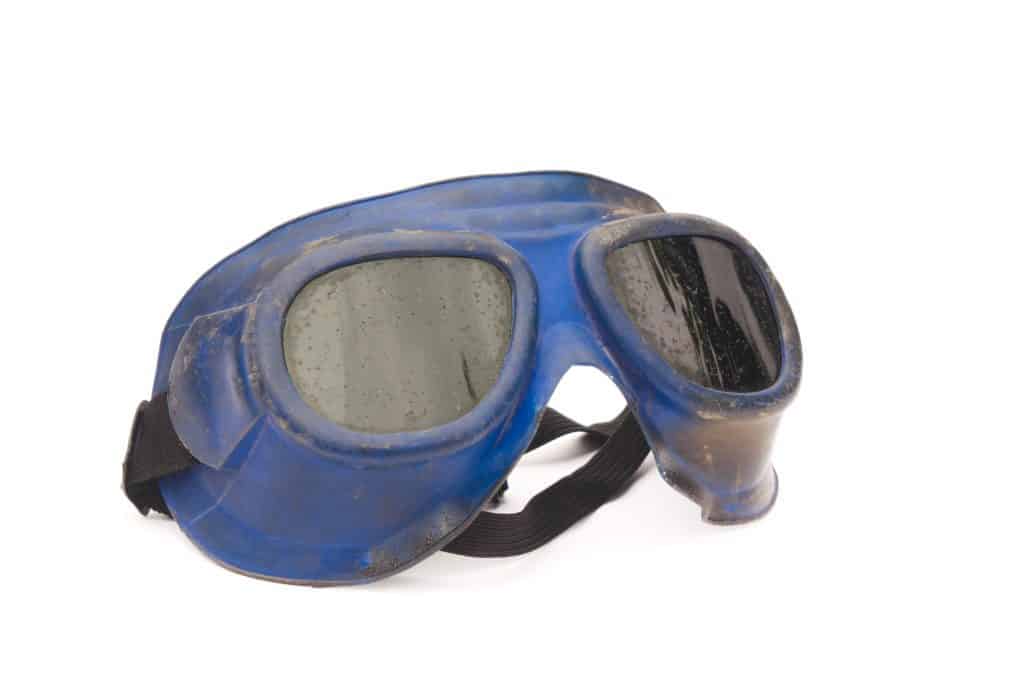
Safety goggles and glasses have their place in the shop, but it’s not while you are holding a welding torch. Welding puts out sparks, spatter, and intense light. You don’t want your face close to that without protection. Even if no projectiles hit your face, the intense light from a welder will sunburn your face in a hurry. Keep up welding like that long enough, and you’ll get skin cancer.
Welding goggles can be useful if you work in a shop with lots of other welders. They are more comfortable to wear around a shop where you are likely to see welding even if you don’t have a torch in hand.
Goggles or glasses are helpful when you are using a grinder. The light from a grinder isn’t enough to see through a welding helmet. The sparks are also easier to control and aim away from your face. Having a pair of safety glasses on hand for grinding and other tasks like it is a good idea.
Other Protective Gear
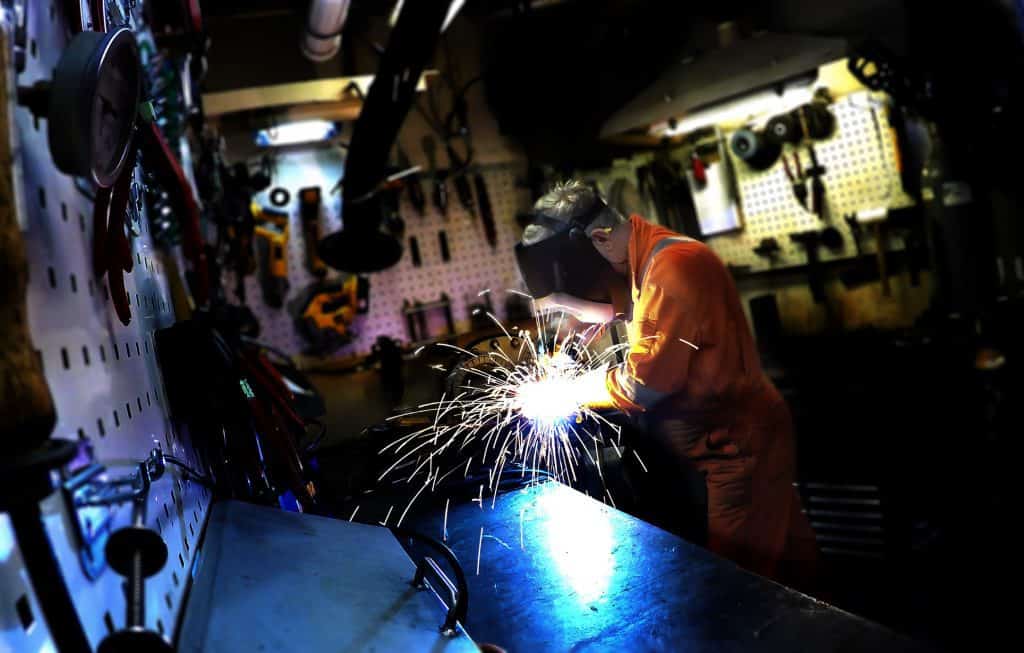
When you weld, you will need more than just a helmet. Welding is a dangerous business, and it requires a full set of protective gear. You will need to suit up from head to toe to stay safe when you are welding.
Gloves
We’ll start with your hands since they are the body part closest to the weld. You need gloves to weld and not just any gloves. Welding gloves are made with heavy leather and lined with a heat-resistant material to keep your fingers safe. They also have long cuffs to protect your arms and keep sparks out of the sleeve.
A popular addition to gloves for TIG welders is the TIG finger. These fingers are fiberglass and mylar sleeves that fit over either the pinkie finger or the pinky and ring fingers of the hand you use to hold the filler rod. The sleeves let you rest your fingers right on the workpiece as you weld without getting too hot. The ability to rest your fingers reduces fatigue and enables you to make great welds.
Respirators
Welding produces something called “welding fumes.” These fumes are a mix of burned oil, metal particles from the weld, and burnt or vaporized particles from the filler rod and flux. All welding processes produce fumes, but the flux used in stick and flux-cored wire welding are the worst offenders.
To protect yourself from welding fumes, wear a respirator under your helmet. A wide array of respirators are available. The least expensive are disposable fiber masks. Half mask respirators are a little more expensive but offer a better seal. The most expensive options include forced-air purifiers, with a power pack on your belt to push fresh air into the mask, and supplied-air respirators that feed fresh air from a distant source.
Clothing
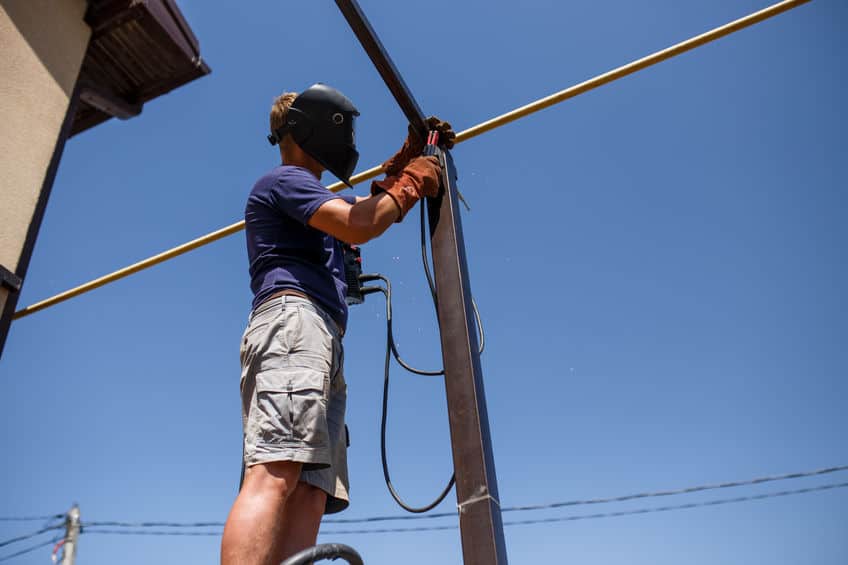
When you weld, you need to wear long sleeves and pants to protect your body from sparks. If you are doing lots of welding, it is worth it to buy a welding jacket and pants. These are heavy leather garments that will keep sparks and flames at bay. These items aren’t cheap, but they are great protection. Welding jackets will last for years without wearing out and outlast many shirts and pairs of pants.
The bare minimum for welding clothes is heavy cotton. Jeans are fine for work pants, and heavy twill or denim shirts work fine. The next step up from cotton is flame-retardant work clothes. These are treated with chemicals to stand up to sparks better than plain cotton.
You should also wear a shirt with a collar or a high neck for welding. Exposed skin on your neck can sunburn while you weld, so don’t wear a t-shirt with a low neck. You need to cover the skin on your neck up to the bottom of the welding helmet.
Don’t wear nylon, polyester, or other synthetic fabrics for welding. These clothes are all basically plastic, and sparks will make them melt. The melted plastic can stick to your skin, then pull the skin away from the burn. Under some conditions, the synthetic fabric can even catch fire. Welding in the synthetic material is worse than welding naked – don’t to it.
Button Up
Keep your clothing buttoned up, and don’t roll up sleeves or cuffs. Keep your gloves over your sleeves and your pants over the tops of your boots. Open pockets, cuffs, or other exposed openings in your clothes can catch sparks. At best, getting a spark inside a cuff will give you an uncomfortable burn. At worst, it can catch your clothing on fire.
Boots
You also need serious boots for welding. Leather is the material of choice here. Light, breathable athletic shoes or hiking boots have nylon panels for breathability. This means burns. You also want a higher-topped boot instead of low shoes to protect your ankle from sparks.
If you can opt for the cowboy or wellington-style boots instead of lace ups, Sparks can burn the laces out of boots. If you do choose lace-up boots, look for leather for fire-resistant laces to protect them. You don’t want to burn your shoes off your feet.
Fire Extinguisher
Welding generates enormous heat and throws hot sparks all over the place. The heat and sparks can easily start fires if you aren’t careful. The best fire protection is to make sure there is nothing flammable near where you are welding. You can’t clean up everything, so make sure to have a fire extinguisher on hand while you weld. If you’re lucky, you’ll never need it. If you do need it, you’ll be glad to have it handy.
Use Your Head
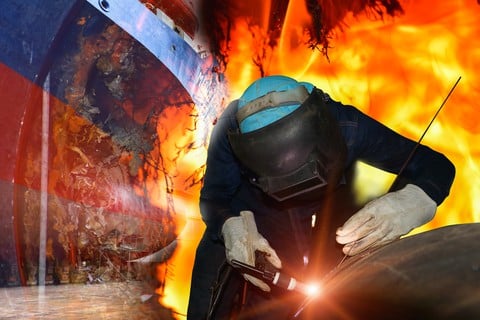
Protective clothing and equipment is the last line of defense for you when you are welding. These items protect you from dangers that happen, but it’s better if you stay out of dangerous situations in the first place.
The most important piece of safety equipment is sitting on top of your neck. Understand the dangers inherent in welding and know how to protect yourself. Pay attention to what is going on around you while you work. If something feels dangerous, don’t do it. All the protective gear in the world won’t save you if you do dumb things.
Some other useful safety tips include:
- Read the manual. Don’t assume you know how a new piece of equipment works. Spend some time with the manufacturer’s directions to make sure you can safely operate the equipment.
- Keep it clean. A messy shop is a dangerous shop. It is easy to trip and fall into a cluttered shop. It’s even easier when you can’t see it because you are wearing a welding mask. Put things away and make sure you have plenty of room to work.
- Store flammable material safely. The heat and sparks from welding don’t mix with flammable chemicals. Secure flammable chemicals in a cabinet before you start welding. Keep gas cylinders stored securely away from the work area when you aren’t using them.
- Be careful with electrodes. Don’t weld with wet gloves or clothing, and don’t weld when the floor is wet. Welding uses high-powered electrical currents. You don’t want to come in contact with them.
Done right, welding can be a lot of fun. Getting hurt while welding is not fun. Choosing a good helmet and other safety gear and following some basic safety procedures will have you enjoying welding for years to come.

